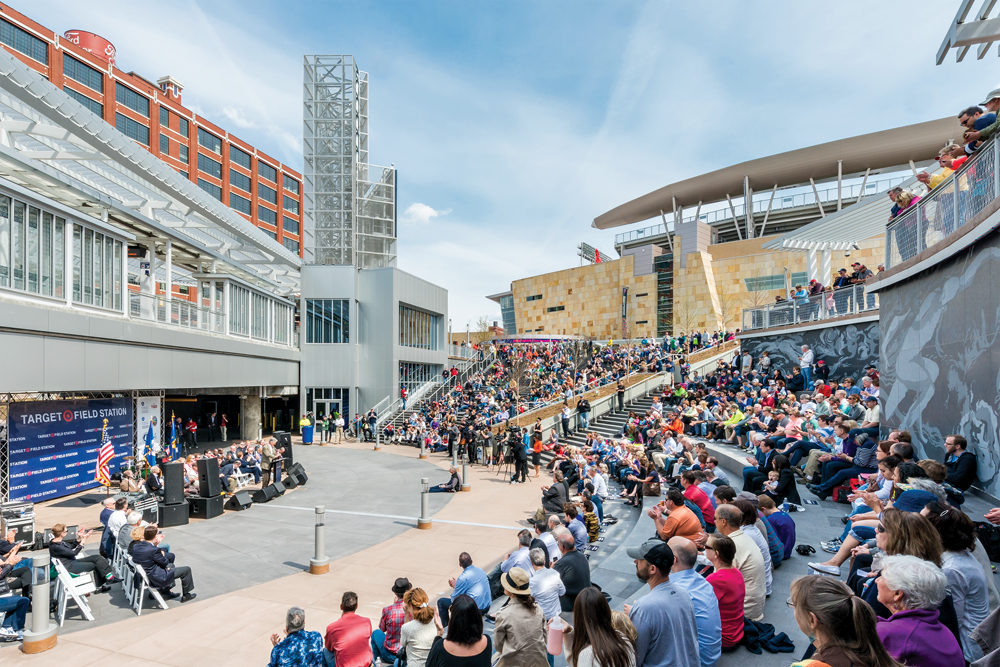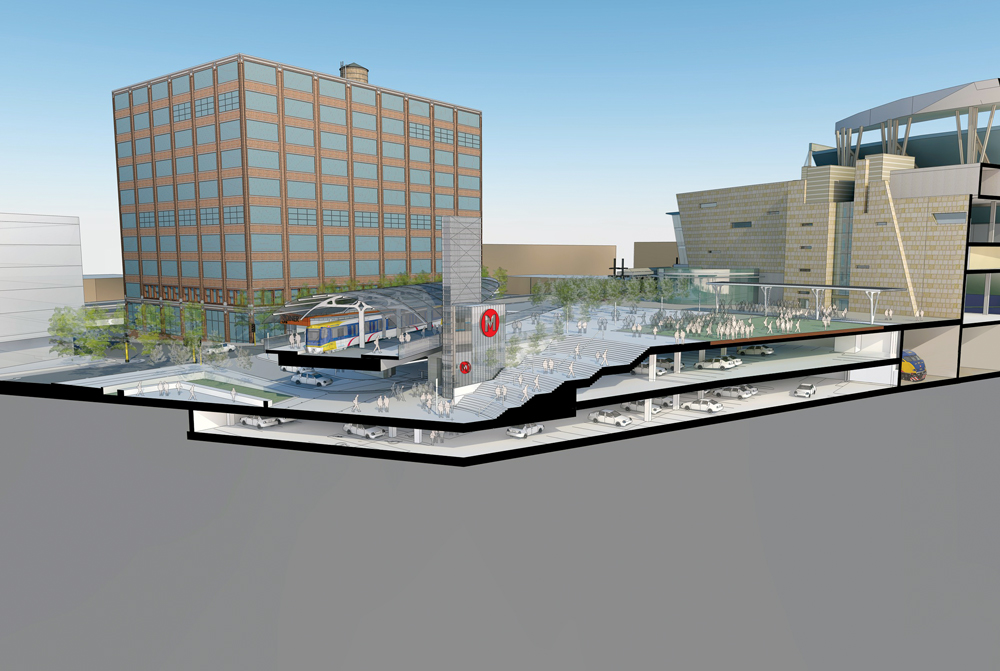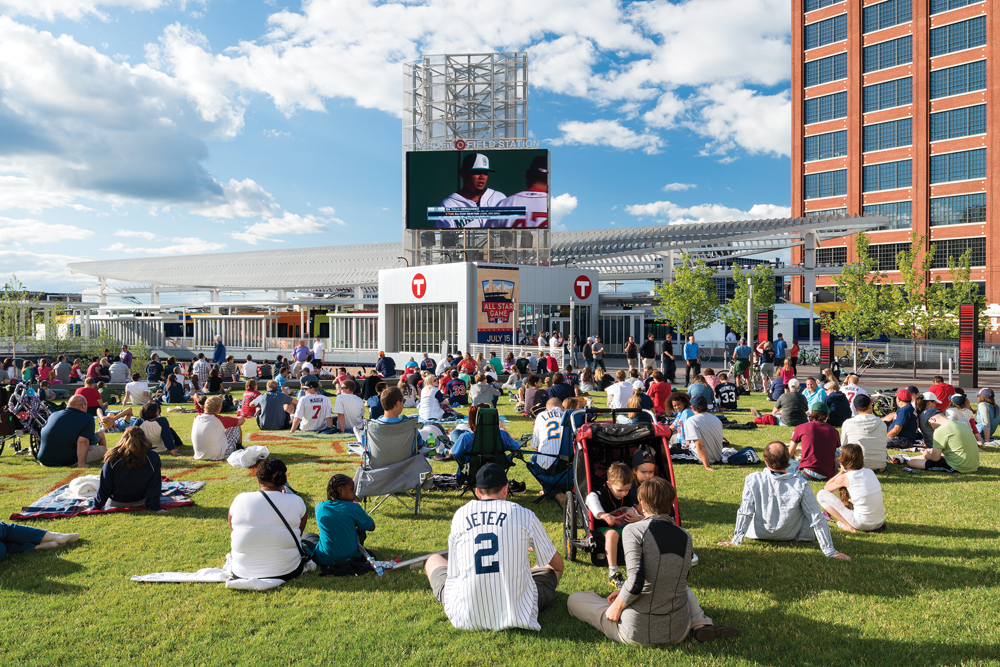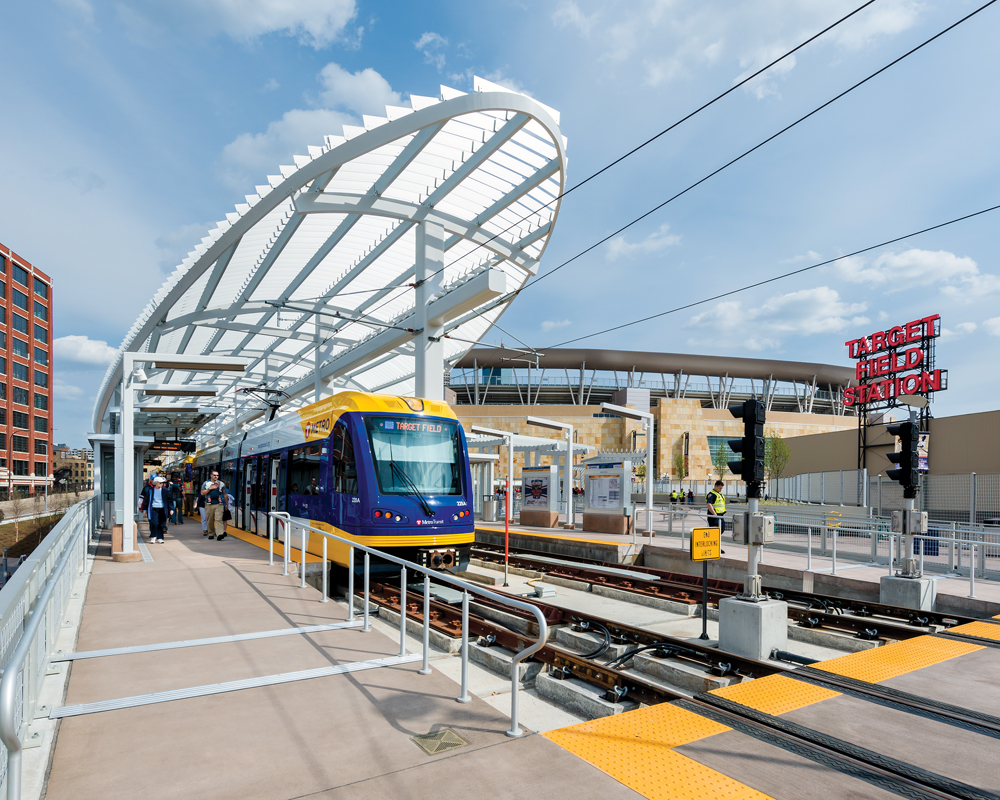Start with the train. Add something called “urban experience.” Turn it into a performance.
That was the thinking behind Target Field Station, which opened last May 17 in Minneapolis. The new light rail station connects the western terminus of the Metro Transit Green Line at Target Field, home of Major League Baseball’s Minnesota Twins, to its bookend 11 miles east at Union Station in St. Paul.
The 7,022-sf station, part of a 140,000-sf complex in the city’s ultra-hot North Loop, is the product of an intense design competition held in late 2011.
A design-build team led by New York–based architecture firm Perkins Eastman and local GC firm Knutson Construction beat four competitors to win the $82.5 million contract.
The design firm’s “Open Transit” concept was the key to the project. “It’s a design philosophy that comes from one principle: to create transit facilities that are so attractive people want to be there regardless of whether or not they’re taking a train,” says Peter Cavaluzzi, FAIA, Principal, Perkins Eastman. “Think about it as a live performance, and the trains are part of the performance.”
Cavaluzzi, who came to Perkins Eastman in a merger with EE&K in 2011, singles out New York’s Grand Central Terminal as the embodiment of Open Transit. “You have 750,000 people a day using Grand Central, but less than half actually board a train or subway car,” he says. Most come to shop, dine, people-watch, or simply to breathe in the magnificence of the space.

The amphitheater has become a popular space for civic events, concerts, and informal gatherings. It is a key element of the “Open Transit” philosophy, a design approach that seeks to make transit facilities so attractive people want to be there even if they’re not taking the train. Photo: © Morgan Sheff
As we’ll see, Target Field Station has, in its brief lifespan, already established itself as a lively performance space, attracting crowds for music, films, and sporting events. It is igniting real estate development in the North Loop at a sizzling rate. It has become the node of integration for multiple modes of transport—busses, trains, bicycles and, yes, even cars. And, in less than a year, it has turned into something of a—dare we say it? —iconic destination in the Twin Cities.
But first, let’s take a step back a bit into the station’s history.
KEEPING UP WITH DEMAND FOR TRANSIT
Before there was a Green Line, there was the Hiawatha, a 12-mile light rail line from downtown Minneapolis to the airport and the Mall of America, in Bloomington. The Hiawatha made its first headway on June 26, 2004. In November 2009, a new station, the Interchange, was opened to serve the North Loop neighborhood and Target Field, the nearly completed new home of the Twins.
Preliminary engineering for a second transit line was started in late 2006. Called the Central Corridor, it was planned to run along University Avenue from downtown St. Paul and the University of Minnesota to Minneapolis, terminating at the Interchange.
It took another four years for the Metropolitan Council, the regional planning agency in charge of the project, to come up with the initial $909 million funding and obtain environmental impact approvals from the federal government. Final design for the new rail line was completed in May 2010, shortly after Target Field opened.
Even before construction got under way, in late 2010, local officials worried that they had what Hennepin County Commissioner Peter McLaughlin would later call “a transit capacity problem.” Ridership on the Hiawatha, which had been strong from the start, went off the charts, especially on game days. “More people were taking the train to Target Field than we had expected,” he says.
Transit planners were concerned that, with the anticipated additional ridership from the Central Corridor line, and with two more extensions planned to the northwest and southwest, it might take two hours to clear the Interchange platform on a busy game day. Commuters were also attempting to cross live tracks to get from the Northstar suburban line to the transit platform.

The Cascade provides a three-dimensional experience for commuters and visitors to the station, some of whom have been known to run up the stairs and thrust their arms in the air à la Rocky. Rendering courtesy Perkins Eastman
“We needed to deal with the safety problems, and we needed better service,” said McLaughlin, Chair of the five-county regional Counties Transit Improvement Board. It was clear that the Interchange hub would have to be completely revamped, and it would have to be elevated.
Before that could happen, McLaughlin and other transit advocates had to sell the idea to the North Loop community, which Forbes would later name one of America’s top 20 hipster neighborhoods. “There were a lot of New Urbanist sensibilities there, and they opposed having an elevated station,” says McLaughlin. “They wanted it at street level.”
In late 2011, at a two-day charrette with stakeholders, the transit planners came up with a scheme to pull the station closer to the adjacent Hennepin Energy Recovery Center (“The HERC”), the county’s waste-to-energy facility. This would clear enough room to elevate the tracks, open up space for a storage track, and pave the way for much-needed street improvements in the surrounding neighborhood.
Getting the job done in the worst winter in 30 years
The last six months of construction on Target Field Station took place during the worst winter in 30 years in Minnesota, and that’s saying something. Crews from Knutson Construction had to bear up against 23 days of -25?F weather. They worked six days a week and some Sundays to get the station ready for its May 17, 2014, opening.
Pouring colored concrete for the plaza and walkways took some doing. “Colored concrete is so finicky,” says Rob Bremer, Knutson’s Project Manager on the job. To to maintain the consistency in the frigid cold, crews erected 20x20-foot stick-frame shelters, covered them with plastic, and poured the concrete in 10x10-foot squares. It was not fun. “Working in a 20x20 enclosure, your productivity goes way down,” he says.
Knutson crews had to take a similar tack in order to paint and caulk the massive canopy that covers the station platform. They erected scaffolding over the entire structure and covered it in reinforced polyethylene tarp. Three-fourths of the forms for the 286-car parking ramp had to be cut and set by hand to account for numerous dimensional changes.
The city wanted nothing to do with hauling snow from the station, so more than 50 miles of snow-melt tubing was installed. “Salt would only discolor the concrete,” says Bremer.
The logistical problems seemed endless. The plan called for reconfiguring the entrance to the waste-to-energy facility, but HERC staff were deaf to any talk of interrupting the flow of their trucks—365 a day. Knutson put in a temporary road for the haulers, and then created a wider entrance with a snow-melt system. The contractor also had to rebuild nearly 250 feet of a four-lane road right next to the municipal bus hub.
Work had to be halted to accommodate 10-12 BNSF freight trains every day. “We had to have a BNSF flagger out there, and when the train was a mile away, everything had to stop, and then we’d have to wait till it was a mile past us,” says Bremer.
Structural engineering for the project was equally problematic, says Swami Palanisami, PE, Owner and Principal, Palanisami & Associates. No task was more difficult than getting the loads right for the Cascade. Palanisami used a technique he calls staged post-tensioning: “We’d put some load on and tension the cable, then more load and tension the cable, and so on,” he recalls. “Every beam, every column was like a piece of artwork.”
Palanisami says Target Field Station posed “some of the most complex geometries I’ve ever worked on in my 44 years as an engineer.”
“The charrette turned the tide,” says McLaughlin. The North Loop neighborhood bought into elevating the Interchange. In 2011, Hennepin County issued an RFP to design-build teams to bid on the project.
All the bids came in over budget, and the county had to recalibrate its numbers. In December 2011, the five finalists were given until March, less than three months away, to resubmit their bids.
COMING IN STRONG FROM WAY BACK IN THE PACK
“We were a dark horse,” says Cavaluzzi, referring to the Perkins Eastman/Knutson Construction design-build team. “We came in late, but the good thing is, it became a contest for the best design, not just the lowest bidder.”
In July 2012, their $85.2 million bid was selected. As Hennepin County’s McLaughlin put it, “The RFP process was difficult, but we got a great product.”
Last May 17, less than two years from the start of construction, the newly named Target Field Station officially opened. (Target Corporation paid $1.75 million for the naming rights.) On June 14, 2014, the newly christened Green Line started service at 18 new stations and five it shares with the Blue Line, the new name for the Hiawatha Line.
Two features put the Perkins Eastman/Knutson bid over the top in the bidding: the Great Lawn and the Cascade. These Open Transit elements transfigured what could have been a run-of-the-mill train stop into an instant urban village.
The 7,100-sf Great Lawn, designed in cooperation with landscape architect Olin/SEH, quickly turned into a popular gathering spot for pregame events, concerts, and casual outdoor activities. A 16x29-foot video board (donated by Target Corporation) sits atop the elevator core, making it visible from the Great Lawn and upper plaza. Last summer, it became the place to watch World Cup soccer and Twins games, and there were movie nights and music events.
A 1,000-seat amphitheater and a sloping, informal seating area form the second Open Transit feature, the Cascade. To Cavaluzzi, the amphitheater’s thrust stage recalls Ralph Rapson’s Guthrie Theater. (Cavaluzzi received his MArch from the University of Minnesota and was a Minnesota Architectural Foundation Ralph Rapson Fellow.) Live concerts sponsored by a local radio station have attracted enthusiastic crowds.
Cavaluzzi says the Cascade pays homage to Olmsted and Vaux’s Bethesda Terrace in New York’s Central Park—with a touch of Philadelphia thrown in: “People feel compelled to dash up to the top and pump their fists like Rocky,” he says.
All the while the trains glide in overhead—“almost whisper-quiet,” says Cavaluzzi. “Think of it as a live performance venue, and the trains are part of the performance.”
In addition to the Great Lawn and the Cascade, Target Field Station benefits from many hidden touches, chief of which is a snow-melt system that uses waste heat from “The HERC” to pump warm water through 50 miles of pipe. This keeps the plaza clear of snow and makes it much more attractive, even in the worst days of the Minnesota winter. Colored concrete was scored, sandblasted, and otherwise treated with a variety of finishes for optimal aesthetic effect.
The green roof and a system of tree pits collect stormwater, which is filtered and stored in giant cisterns that can hold 40,000 gallons. Lighting designer Schuler Shook created a light garden with nine programmable wall fixtures and light sticks; the canopy above the LRT station platform is lit with programmable LEDs.

The Great Lawn has become the place where even a Yankee fan can enjoy the live broadcast of a Minnesota Twins’ game. Last June and July it was the hot spot to catch World Cup soccer on the 16x29-foot video board. Landscaping and architectural features like this have made Target Field Station an entertainment venue and community gathering space, not just a transportation hub. Photo: © Morgan Sheff
The project is certified under LEED and Minnesota’s “Buildings, Benchmarks and Beyond” guidelines. Cavaluzzi says that standard measures of sustainability are difficult to apply to a transit station. He argues that, by enabling year-round use, the station is, by its very nature, highly sustainable.
According to the Minneapolis Star-Tribune, about a third of the financing came from the federal government, 30% from the county, 20% from the state, and the rest from the city and the Minnesota Ballpark Authority. The Twins and United Properties, a division of the Pohlan Family Companies (the owners of the ballpark), chipped in $3.6 million.
TALLYING UP THE PAYOFF
Development activity in the North Loop is proceeding at what the Star-Tribune has called “a blistering pace.” Office buildings, retail stores, and apartment buildings are replacing desolate parking lots in the old red-brick industrial district.
In November, Trammell Crow had no trouble flipping its 182-unit Junction Flats apartment complex, which it completed just a few months before, for $49 million.
Hines has several projects going in the North Loop, the latest a 210,000-sf, seven-story wooden speculative office building it’s calling T3 (for “timber, transit, technology”).
United Properties is beavering away on a $60 million headquarters that will house 800 employees of Be the Match, the nonprofit bone marrow registry. United also completed the renovation of the 10-story Ford Center, a 270,131-sf historic Model T factory across from the station, and the 112,645-sf Loose-Wiles Biscuit Company Building; both are about 99% leased.
In November, United Properties announced plans for Target Field Station Center, a 10-story, 240,000-sf office building that it will develop on spec—another sign of the transit node’s vitality. United is in the process of buying a three-quarter-acre parcel for the project from Hennepin County for $1.5 million; the county will get $15/sf (minus the $1.5 million) from future leases. “That could net out to $2 million,” says Commissioner McLaughlin.
McLaughlin recently reflected on the county’s original vision for the project. “We wanted a transit station that worked well, but we also wanted a public space that would be noteworthy, a statement—not just for 81 home baseball games, but a great civic space that would function 365 days a year.”
By all accounts, Target Field Station is well on its way to realizing that vision.
Related Stories
| Feb 11, 2011
Grocery store anchors shopping center in Miami arts/entertainment district
18Biscayne is a 57,200-sf urban retail center being developed in downtown Miami by commercial real estate firm Stiles. Construction on the three-story center is being fast-tracked for completion in early 2012. The project is anchored by a 49,200-sf Publix market with bakery, pharmacy, and café with outdoor seating. An additional 8,000 sf of retail space will front Biscayne Boulevard. The complex is in close proximity to the Adrienne Arsht Center for the Performing Arts, the downtown Miami entertainment district, and the Omni neighborhood, one of the city’s fast-growing residential areas.
| Feb 11, 2011
Chicago architecture firm planning one of China’s tallest towers
Chicago-based Goettsch Partners was commissioned by developer Guangzhou R&F Properties Co. Ltd. to design a new 294,570-sm mixed-use tower in Tianjin, China. The Tianjin R&F Guangdong Tower will be located within the city’s newly planned business district, and at 439 meters it will be one of China’s tallest buildings. The massive complex will feature 134,900 sm of Class A office space, a 400-key, five-star hotel, 55 condominiums, and 8,550 sm of retail space. The architects are designing the tower with multi-story atriums and a high-performance curtain wall to bring daylight deep into the building, thereby creating deeper lease spans. The project is currently finishing design.
| Feb 11, 2011
Two projects seek to reinvigorate Los Angeles County medical center
HMC Architects designed two new buildings for the Los Angeles County Martin Luther King, Jr., Medical Center as part of a $360 million plan to reinvigorate the campus. The buildings include a 120-bed hospital, which involves renovation of an existing tower and several support buildings, and the construction of a new multi-service ambulatory care center. The new facilities will have large expanses of glass at all waiting and public areas for unobstructed views of downtown Los Angeles. A curved glass entrance canopy will unite the two buildings. When both projects are completed—the hospital in 2012 and the ambulatory care center in 2013—the campus will have added more than 460,000 sf of space. The hospital will seek LEED certification, while the ambulatory care center is targeting LEED Silver.
| Feb 11, 2011
Sustainable community center to serve Angelinos in need
Harbor Interfaith Services, a nonprofit serving the homeless and working poor in the Harbor Area and South Bay communities of Los Angeles, engaged Withee Malcolm Architects to design a new 15,000-sf family resource center. The architects, who are working pro bono for the initial phase, created a family-centered design that consolidates all programs into a single building. The new three-story space will house a resource center, food pantry, nursery and pre-school, and administrative offices, plus indoor and outdoor play spaces and underground parking. The building’s scale and setbacks will help it blend with its residential neighbors, while its low-flow fixtures, low-VOC and recycled materials, and energy-efficient mechanical equipment and appliances will help it earn LEED certification.
| Feb 11, 2011
Texas megachurch inspired by yesteryear’s materials, today’s design vocabulary
The third phase of The First Baptist Church of Pasadena, Texas, involves construction of a new 115,000-sf worship center addition. Currently in design by Zeigler Cooper, the project will include a 2,500-seat worship center (with circular layout and space for a 50-person orchestra and 200-person choir), a 500-seat chapel (for weddings, funerals, and special events), and a prayer room. The addition will connect to the existing church and create a Christian Commons for education, administration, music, and fellowship. The church asked for a modern design that uses traditional materials, such as stone, brick, and stained glass. Construction is scheduled to begin this summer.
| Feb 11, 2011
Apartment complex caters to University of Minnesota students
Twin Cities firm Elness Swenson Graham Architects designed the new Stadium Village Flats, in the University of Minnesota’s East Bank Campus, with students in mind. The $30 million, six-story residential/retail complex will include 120 furnished apartments with fitness rooms and lounges on each floor. More than 5,000 sf of first-floor retail space and two levels of below-ground parking will complete the complex. Opus AE Group Inc., based in Minneapolis, will provide structural engineering services.
| Feb 11, 2011
Four-story library at Salem State will hold half a million—get this—books!
Salem State University in Massachusetts broke ground on a new library and learning center in December. The new four-story library will include instructional labs, group study rooms, and a testing center. The modern, 124,000-sf design by Boston-based Shepley Bulfinch includes space for 500,000 books and study space for up to a thousand students. Sustainable features include geothermal heating and cooling, rainwater harvesting, and low-flow plumbing fixtures.
| Feb 11, 2011
Green design, white snow at Egyptian desert retail complex
The Mall of Egypt will be a 135,000-sm retail and entertainment complex in Cairo’s modern 6th of October district. The two-story center is divided into three themed zones—The City, which is arranged as a series of streets lined with retail and public spaces; The Desert Valley, which contains upscale department stores, international retailers, and a central courtyard for music and other cultural events; and The Crystal, which will include leisure and entertainment venues, including a cinema and indoor snow park. RTKL is designing the massive complex to LEED Silver standards.
| Feb 10, 2011
7 Things to Know About Impact Glazing and Fire-rated Glass
Back-to-basics answers to seven common questions about impact glazing and fire-rated glass.
| Feb 10, 2011
Medical Data Center Sets High Bar for BIM Design Team
The construction of a new data center becomes a test case for BIM’s ability to enhance project delivery across an entire medical campus.

















